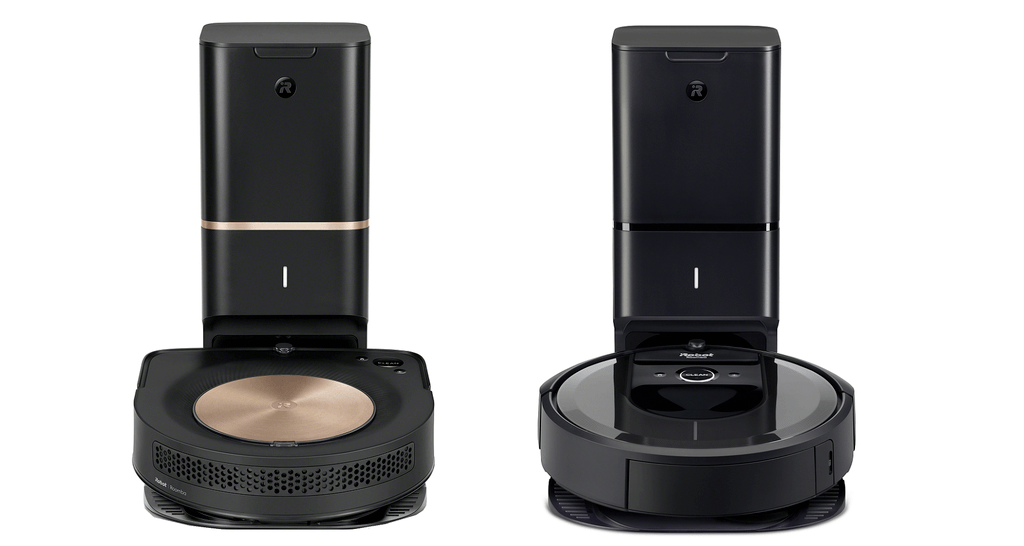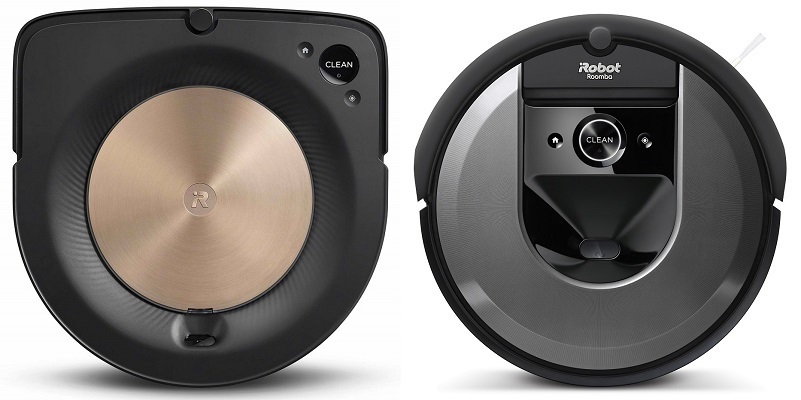Updated: November 21, 2022
Differences between the Roomba s9+ and Roomba i7+
- The s9+ has better edge and corner cleaning due to its shape
- Roomba s9+ has a slower spinning side brush to better pull in debris
- The s9+’s brushless rollers are now much wider and located in the front of the Roomba for better performance
- The Roomba s9+ has stronger suction, much better cleaning on both carpet and hard surfaces
- The s9+’s wheel design makes it better than the i7+ at climbing over obstacles such as transition molding
Similarities between the Roomba s9+ and Roomba i7+
While the s9+ seems to be a complete redesign of the entire Roomba line, there are still quite a few similarities that were carried over. Take a look.
- Both the s9+ and i7+ will automatically recharge, and resume vacuuming if not finished
- Both robots use voice commands and the iRobot Home app for control options.
- Each uses camera-based navigation (vSLAM) to map and move through the home.
- You can program and schedule the robots to clean the entire home or a single room.
- Each will also automatically empty their collection bins into the Clean Base charging station.
- Entire floor cleaning means that both robots will resume cleaning after the batteries are charged.
- Both the s9+ and the i7+ come with Imprint Link to allow communications with Braava mopping robots.
If you don’t have time to read the whole article, here is the summary:
If you have a budget to stay under and you want a robot that empties itself, go for the Roomba i7+. It’s an extremely well made robot vacuum and in practical use you won’t be able to tell the difference between it and the s9+.
If you have a budget to stay under and you don’t care about self-emptying, opt for the Roomba s9 (without the plus, meaning without the auto-emptying clean base). You will have to clean out the dust bin yourself, but you save a bunch of money in the process and still get the most advanced robot vacuum ever made.
If money is no object and you want the best self emptying robot vacuum, then your choice is natural: go with the Roomba s9+.
Contents
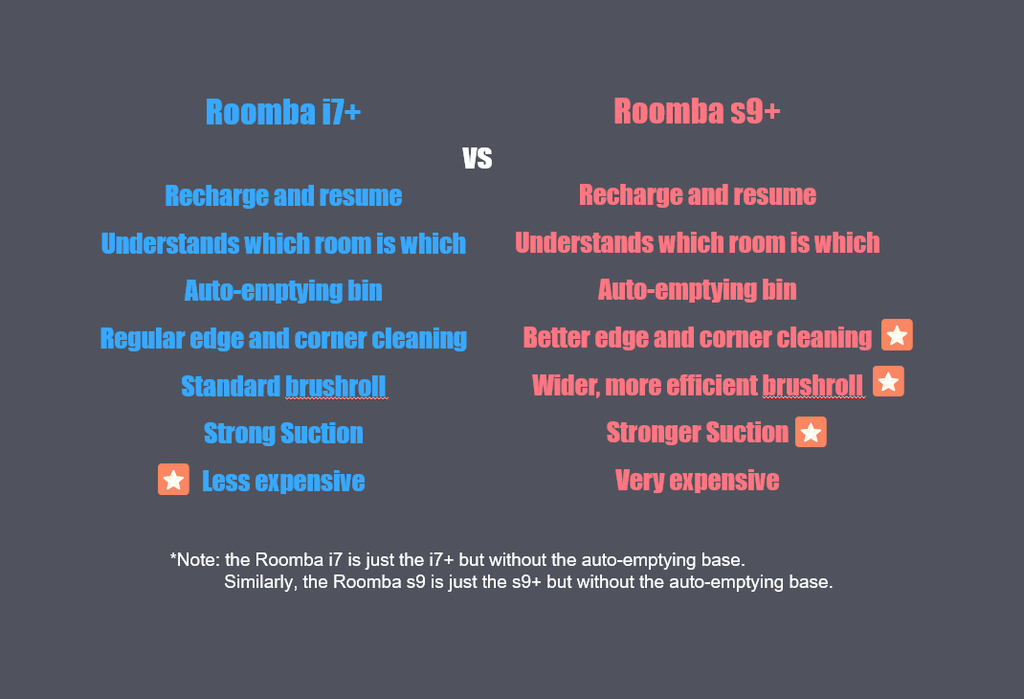
Comparison Table
Now that we have covered the most important differences and similarities, lets see the two robots side by side to see how they compare.
| Roomba s9+ | Roomba i7+ | |
| Size | 12.25 x 12.25 x 3.5 inches | 13.34 x 13.34 x 3.63 inches |
| Weight | 8.15 pounds | 7.44 pounds |
| Navigation | iAdapt 3.0 | iAdapt 3.0 |
| Runtime | Up to 120 minutes | Up to 120 minutes |
| Charge Time | 3 hours | 3 hours |
| Automatic Recharge | Yes | Yes |
| Entire Level Clean | Yes | Yes |
| Filter | High-efficiency | High-efficiency |
| Wireless Communications | Yes | Yes |
| Mobile App | Yes | Yes |
| Voice Controls | Yes | Yes |
| Floor Types | All | All |
| Imprint Smart Mapping | Yes | Yes |
| Imprint Link | Yes | Yes |
| Collection Bin Capacity | 0.55L | 0.7L |
| Washable Collection Bin | Yes | Yes |
| Automatic Collection Bin Emptying | Yes | Yes |
| Side Brushes | 1 Side Brush | 1 Side Brush |
| Containment | Separate Purchase | Dual Mode Virtual Wall Barrier |
| Warranty | 1 Year | 1 year |
| Price | Check on Amazon | Check on Amazon |
Comparing the Roomba s9+ to the Roomba i7+ in Detail
When the iRobot CEO, Colin Angle, stated that the Roomba i7+ was as close as they have ever come to their original vision, we assumed that we might have reached the pinnacle of robotic vacuums. However, just seven short months later, we have the release of the Roomba s9+, a vacuum that promises to be even better.
Let us now take a look at the features and options of both models in a close up, apples to apples comparison. You will soon see which model is better suited for your needs, budget and home.
When it comes to mapping your home and cleaning your floors following the created maps, Roomba robots have always been among the best.
With the advent of the camera-based vSLAM technology, the 900 series and newer robots have been cleaning more and more like humans. The parallel paths and cleaning patterns mimic human vacuum patterns to ensure a more thorough clean.
The i7+ makes multiple passes to ensure the entire floor space is cleaned. The s9+, however, appears to be more efficient in the cleaning process.
The first pass is a general run through of the space, followed by a more complete cleaning pass. The areas that were missed are gone over once more and the s9+ follows it all up with an edge cleaning pass to complete the room.
The i7+ is relatively similar in the cleaning passes, although it tends to miss more spots, or at least not return to all of them the way the s9+ does.
While iRobot is tight-lipped about the cleaning algorithms, it is clear that the s9+ has a different mindset and makes more human-like decisions about where to go.
Bottom Line: The s9+ and i7+ use the same iAdapt technology, though the s9+ seems to utilize it better, making more efficient and thorough cleaning passes.
The i7+ Uses the Battery Less Efficiently than the s9+
One thing we aren’t exactly sure about is the cell size of the Roomba s9’s battery. It is most likely the same 3600mAh lithium-ion that comes with the i7 model, though as of this writing iRobot hasn’t released the official data.
While the data will be held for a few more months, we can make assumptions based on the history of the company. One is that they don’t like having different battery styles. This was proven when they did away with their multiple battery sizes and stayed with the 1800mAh, the 3300 XLife battery and the 3600mAh that was released with the 900 series.
We also know that both the i7 and the s9 tout runtimes of up to 120 minutes, which has been the standard since the late 900 series Roombas were brought to market.
The actual battery size doesn’t matter much anymore, though. Roomba is steering all of their models to the recharge and resume model. This means that if a cleaning cycle can be completed in a single charge, the robots will return to the dock, recharge their batteries and then resume cleaning where they left off.
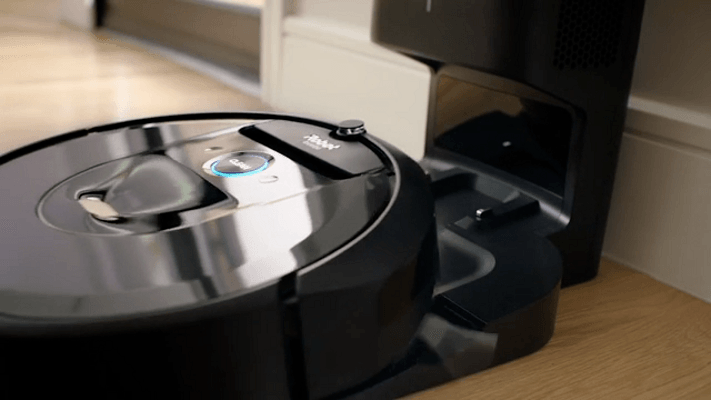
Also known as “entire floor cleaning,” this feature is available on every Roomba that has camera-based navigation and maps your homes.
Here is what we do know: The i7+ won’t ever see a full 120 minutes of runtime. The average, on mix flooring (hard floor and carpet), is about 80 to 90 minutes. The i7+ will clean in human-like patterns and does a more thorough job than most other models that came before it.
On the other hand, the s9+ will get a lot closer to the full 120 minutes. This is primarily due to the removal of motor speed automation.
The i7 series was fully autonomous and you couldn’t change settings such as motor speed. The motor only had one speed and the carpet boost. The s9, however, allows you the ability to choose low speed, high speed, or automatic.
When left in automatic, the robot will decide, based on debris and floor type, which mode is best. It also does a decent job of making that decision. Resulting in a longer runtime, deeper, more thorough clean and about 400 to 500 square foot more of cleaning area.
Bottom Line: The s9 is more efficient with its battery use, resulting in a longer runtime.
How Should One Measure Suction?
When getting into the technical side of things, you will often hear phrases such as air flow, air pressure, pascals, and cubic feet per minute thrown around.
Now, without bringing numbers and math into it, how powerful are they?
The Roomba i7 will pick up hair, sand, coffee grounds, cereal, pet litter, and will probably move a sock around a few rooms before it dislodges it.
The Roomba s9 will pick up all of those (the sock, too), and be able to carry around a shoe (probably) for a room or two.
The s9 has more suction power, and the 30 percent wider brushless rollers also play a part. They have been moved from the middle of the machine (as in the case of all older Roombas) to the front. Because they are slightly lower to the ground and in the front of the unit, the power of suction is increased.
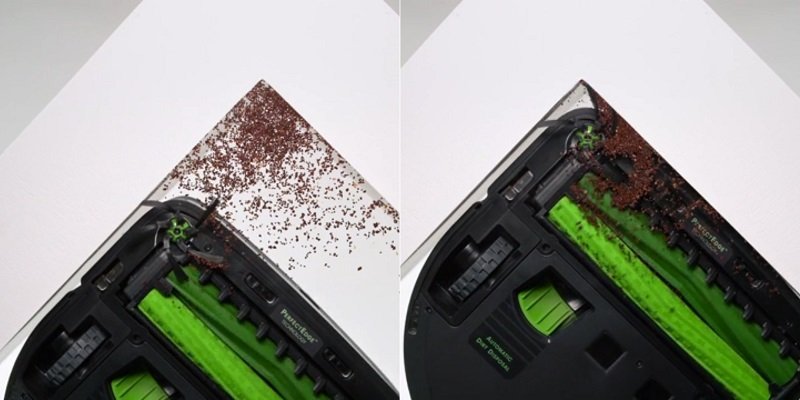
So while both machines will get sand out of your carpet, the s9 will go deeper, picking up even more sand than the i7. The s9’s power is just shy of your standard upright, plug-in model which will get almost all of the sand.
Where the i7 stands out, though, is on larger debris. Such things as dry cereal, fish tank pellets, etc. won’t bother the i7. Both machines will clean up virtually all of the large debris on your floors.
When the s9 encounters larger debris pieces, you will probably hear it. It will crunch and crack and fling (internally), making quite a racket. The i7 will make some noise, of course, but not near as much as the s9.
Both Models Will Self-Empty Their Collection Bins
When the collection bins get full, you don’t need to worry about that, either. Both the i7+ and the s9+ have a Clean Base. The Clean Base is the charging station with a motor. When the robots dock, the motor kicks on, sucking out all the debris from the collection bins.
It is then stored in a removable vacuum bag, much akin to what you find in a modern upright. Each bag will hold about 30 collection bins worth of debris.
When the bag gets full you will be alerted and you simply pull it out, toss it away and replace it with a new one.
The significant difference here is that the s9 Clean Base has a new filtration system on it. While both of the robots have the Roomba high-efficiency filter, so does the Clean Base on the s9+ dock. It is hypoallergenic and will keep all in-home allergens in the collection bag where they belong.
Bottom Line: The s9+ has a more powerful motor, great suction and will clean as deep into your carpet fibers as your upright will. The Clean Base is also filtered better than the i7 dock is.
The Controls are More Advanced Than on any Other Robots
When it comes to controlling your robots, you aren’t without options. Both the i7+ and the s9+ use the same control types: local, voice and mobile app.
The local controls are the same, just in a different location on the robots themselves. Because we haven’t talked about the most glaring difference between the two models yet, let’s do so now.
The s9 models are D-shaped, much akin to the Neato D-series robots. The Roomba s9 is just over an inch shorter in width than the Neato robots, though, and the maneuverability problems of Neato are pretty much gone with Roomba’s version.
The i7, on the other hand, is the same round Roomba we’ve come to know and love.
The local controls are the same, though. Each machine has a Clean, Home and Spot clean button located on the faceplate.
Instead of Local Controls, Use Your Voice
Voice commands aren’t anything new. As long as we have had wireless communication with the robots and Amazon Alexa has been around, we’ve been able to use voice commands for control.
Today, they are even more robust. Instead of just starting and stopping a cleaning cycle, you can now use your voice to make, edit and delete cleaning schedules, start, stop, pause, resume or cancel a cleaning cycle and even get status updates and locations of the robot.
There are two new features with the i7 and s9 that you won’t find on any other model: Imprint Smart Mapping and Imprint Link.
Both of these have uses with the mobile app primarily, though the voice commands can now accommodate.
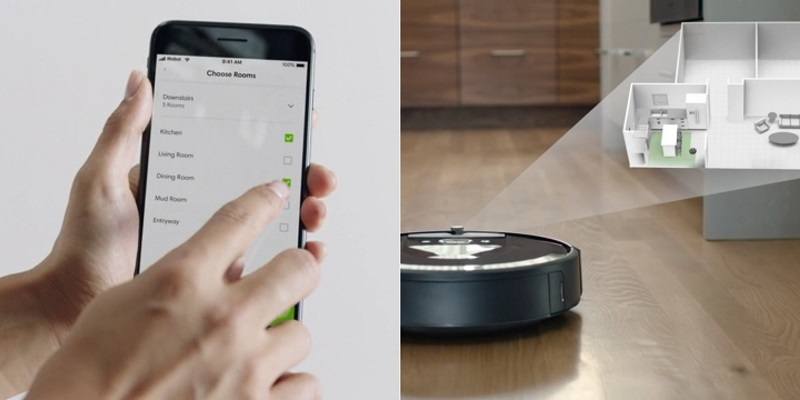
Imprint Smart Mapping is when the robot makes a complete map of your home and you use the mobile app to name the rooms on the map. Once that is done, you can use your voice to have the robot clean a specific room. Saying such things as “Alexa, have Roomba clean the kitchen.”
As of this writing, there isn’t a way to have the robot do two separate rooms (like the kitchen and master bedroom) only. The workaround is to use the mobile app (discussed in a moment) to mark only the rooms you want to be cleaned and then use voice commands to do regular cleaning.
A regular cleaning, with the Imprint Smart Mapping enabled, will only clean the rooms you have marked on the map, not the entire home.
The Imprint Link works with the i7+ or the s9+ and the Braava M6 mopping robot. You can use voice commands to say things like “Alexa, have Roomba clean and Braava mop.” With the linking, the Roomba will go first, cleaning the home and the Braava will follow behind, mopping the floors as the Roomba completes a room.
You can also say, “Alexa, have Roomba clean the bedroom and Braava mop the kitchen.” if you don’t want them working in tandem.
The Mobile App Will See the Most Use, in General
When it comes to control, the most robust, fully featured option is the iRobot Home App. This mobile app is arguably the best in the industry and it keeps getting better.
With the mobile app, you can do all of the same control options as you can with local and voice commands, and a lot more.
You will get to see the maps created by the robots, mark and name rooms, give the robot a name, edit schedules on the fly and see the status of the filter, battery and cleaning cycles, right in the palm of your hand.
As with the voice commands, you can also use the Imprint Link and Smart Mapping with just a few clicks. The best part is that you don’t even need to be home to use these features. You can do them from virtually anywhere as long as your cell phone has reception and your home wireless network is active.
Bottom Line: Both robots are equal here. All the controls are the same and some are exclusive to both models. Aside from the physical location of the buttons, there are no other differences.
Keep Out Zones are Now Supported in Both Models
“Keep Out Zones” arrived via an update on the iRobot Home app (summer 2019). Instead of relying on the virtual walls to block off access to areas you don’t want the robot to clean, you draw rectangular areas on the map of your house in the app. This tells the Roomba s9 or i7 to skip vacuuming those areas.
How is this helpful? This makes your home a “safer” place for the Roomba. Do you always have to rescue your Roomba because it gets stuck under the edge of the cabinets in your kitchen? Draw a little box around that area so the Roomba knows not to go there in the future.
At the time of writing, only the s and i series support this feature.
Bottom Line: Tie. Both vacuums received this update, so it’s a win for both models.
Frequently Asked Questions
I will now answer some of the more common questions about the Roomba s9+ and the i7+. If you still have questions or concerns, please use the comment form at the bottom of the article.
Q. What’s different between the i7 and i7+?
A. The main difference is that the i7 does not have the auto-emptying docking station that the i7+ comes packaged with.
Q. What’s different between the s9 and s9+?
A. The main difference is that the s9 does not come with the auto-emptying docking station as the s9+ does.
Q. Do I have to get the “Plus” model?
A. No, you don’t. In fact, if you are looking to save some money, both the “i” and “s” series come in normal and plus. The i7 and s9 are the same robots as the i7+ and the s9+ (respectively).
[easyazon_image align=”center” height=”500″ identifier=”B07QXM2V6X” locale=”US” src=”https://smartrobotichome.com/wp-content/uploads/2019/06/41GlkV2B9XL.jpg” tag=”srh-easyazon-20″ width=”500″]As discussed above, the difference in the models is the Clean Base self-emptying tower. The plus models come with the Clean Base and a collection bin that will work with it. The standard models come with the Home Base and a collection bin without a hole in the bottom.
Other than the self-emptying collection bins, all other aspects are identical in both versions.
Q. What is the warranty and how do I make a claim?
A. The standard warranty is a 30-day money back guarantee followed by a 1-year warranty on craftsmanship and functionality.
This, of course, will change depending on where you make your purchase, which is why we recommend Amazon. You can extend the warranty by up to 4 years if you purchase through Amazon, and you don’t have to deal with iRobot customer service.
I am not saying the customer service is bad, but there are some horror stories and it is generally accepted that you will have to test and try out a few things before they will push the warranty claim forward.
To make a claim, you will need your model and serial number and contact customer service. You can find all the details on their website. Just be ready with all of your information and be prepared to be on hold for a while.
What I Like About the Roomba i7+
- Able to clean all floor types well
- Can remember up to 10 floor plans with Imprint Smart Mapping
- Self-emptying collection bin
- High-efficiency filter to eliminate up to 99% of in-home allergens
What I Like About the Roomba s9+
- Everything about the i7+ category, plus:
- More efficient battery usage for longer runtimes and more cleaning area
- HEPA quality filter in the Clean Base tower
- Cleans corners and edges better than any other Roomba
In Conclusion
If you haven’t been able to make up your mind by now, you still have some thinking to do.
Both the i7+ and s9+ models are expensive and still new on the market. The Roomba i7+ has more features than any Roomba prior, but is slightly beat by the s9+. Because of the improved suction and enhanced corner and edge cleaning, the s9+ is the better vacuum. But it comes at too high a price.
To summarize, there are three scenarios, depending on how much you want to pay and whether or not you have to have a self-emptying robot vacuum.
The Roomba i7+ is the model to get if (1) you have a budget to stay under and (2) you don’t want to empty it yourself.
The Roomba s9 is the way to go if (1) if you have a budget to stay under and (2) you don’t mind emptying the dust bin yourself.
The Roomba s9+ is the model for you if (1) money is no object and (2) you want the best robot vacuum available. The only negative about the s9+ is its high price.
Click here for all the robot vacuum deals on Amazon today.
